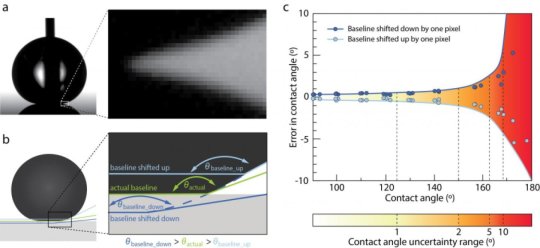[ad_1]
How liquids are repelled by a surface — a property called “wettability”- is important for engineers to develop aircraft that resist ice formation; for fashion designers developing outdoor gear that repels rain and dirt; and every possible field in between. Researchers developing whole new surface materials in the lab also need accurate measurement of wetting properties so they can compare how different surfaces behave. For over two centuries, the standard method for defining how the droplet and the surface interact has been by measuring the “contact angle” of the droplet. The contact angle is the angle between the edge of the droplet and the surface it’s sat upon. Research at Aalto University is now calling the effectiveness of this method into question, in a perspective article published 15 March in the journal Science.
The problem with the contact angle method — according to Professor Robin Ras — is that it depends on both the accuracy of camera used to image the droplet and a subjective decision by the scientist about where in the image the droplet meets the surface. As scientists and engineers develop increasingly water-repellent materials, our ability to measure how effective they are decreases because the errors in the measurement get substantially worse as the ability to repel water increases.
Professor Ras’s team has carefully quantified the errors that arise from contact angle measurements, and his group are developing alternative methods for measuring how water repellent surfaces interact with droplets. Newer methods which measure the adhesion or friction forces between the surface and the droplets not only have lower errors, but allow quantification in physical terms that are more relevant to the engineers developing the new materials.
“We encourage researchers to rethink the relevance of contact angles in hydrophobic surface characterization and propose force as the next-generation benchmark quantity” says Professor Ras.
By raising the awareness among the wider scientific community that better methods for measuring surface wettability are out there, Professor Ras and his team hope that others will be able to make further discoveries currently unobtainable using traditional measurement techniques.
Story Source:
Materials provided by Aalto University. Note: Content may be edited for style and length.
[ad_2]















